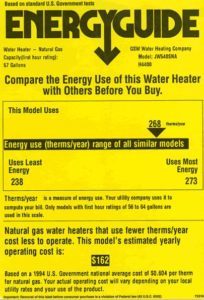What Does the Information on the EnergyGuide Label Mean?
The EnergyGuide label you find on many appliances and electronics provides much of the information you need to make choices based on how much energy the product uses. The U.S. Department of Energy (DOE) requires manufacturers to test and disclose the energy usage of most major appliances and place the information prominently on a bright yellow label.
The label might be on the packaging or the appliance or device itself. The black horizontal line in the middle of the label and its corresponding arrow show how much it costs to use that appliance on an average annual basis.
The DOE averages the cost of energy, as well as typical usage to arrive at these averages, and your individual costs will vary, especially for cooling systems.
Labels for central HVAC systems include their energy efficiency ratings. The DOE sets minimum standards for air conditioners and furnaces. The SEER (seasonal energy efficiency ratio) rating indicates cooling efficiency, HSPF (heating season performance factor) shows the heating efficiency of heat pumps, and AFUE (annual fuel utilization efficiency) tells you how efficiently a gas-burning furnace uses fuel. Higher ratings for HVAC products indicate better efficiency.
The information in the upper right-hand corner of the EnergyGuide label discloses the manufacturer’s name, the model number, and its size or capacity. The box on the opposite side shows features that differentiate that product from others similar to it.
The Energy Star label lies in the bottom right-hand corner if the product qualifies for this status. Given the amount of cooling that homes in Florida require, it’s worth the investment to consider an HVAC product that qualifies for this designation.
Energy Star products use less energy and return the extra investment within a few years of operation. The term “Most Efficient” indicates that the system offers exceptional energy efficiency.
Knowing what the information on the EnergyGuide label stands for helps you select more efficient appliances. To learn more, contact NisAir Air Conditioning and Heating, providing trusted HVAC services for Martin, Palm Beach, and Indian River County homeowners.

